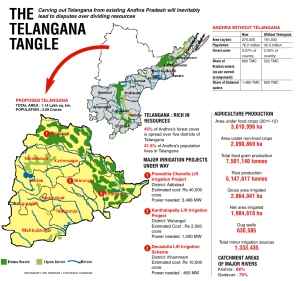Technically speaking, my ethnolinguistic identity is a concoction of different ancestral roots for I am mostly Tamil and partially Telugu. Although it is with slight disappointment that I admit my incompetence in what may, for lack of a better linguistic term, be called my ‘minor’ Mother Tongue at all, it was with avid interest that I read about the fate of the Telugu-speaking state in India. Andhra Pradesh is a state of 84.6 million people in the south of India, east of the Deccan plateau, famous for being a hub of cultural activity and for religious tourism at its ancient temples. However, today, due to differences in political and economic prospects, the state is set to be split into 2 new states, albeit with great resistance due to legislative gridlock.
The ruling Congress Party and its coalition, the United Progressive Alliance (UPA) Government, have heeded the call from a sizeable number of Andhra Pradesh politicians in both the national and state governments to kick-start the process of breaking up the 3 regions of Andhra Pradesh into 2 states – Telangana and Andhra. Proponents of the separation cite the fact that an unequal distribution of economic resources within Andhra Pradesh have resulted in unfavourable prospects for the Telangana region as compared to Coastal Andhra. Historically, Coastal Andhra was more prosperous primarily because of its thriving agricultural sector which benefited more from the Green Revolution than the other parts of the state, providing a further impetus for growth. Another point worth noting is that the Telangana region has a higher percentage of people constitutionally classified under the Scheduled Castes and Tribes, explaining their unfair predisposition towards being stuck on the lower rungs of the socio-economic ladder. Hence, the first noticeable trend in the economic geography of Andhra Pradesh is its widening income and development gaps between regions that differ in the nature of their main industrial activities as well as socio-economic demography.
However, what is so uniquely fascinating about the case of Andhra Pradesh is the fact that the state capital, Hyderabad, is located within the Telangana region itself. Shouldn’t the most developed city in the state bring about positive economic influence for the region in which it lies? After all, Hyderabad is India’s 4th largest credit centre, with 90% of the urban workforce employed in the service sector. It also boasts of a wide array of transnational corporations (TNCs) in the IT sector, including big names such as Google, Yahoo and Facebook, that have set up research and development (R&D) centres there. However, the concentration of economic resources and generation of revenue in Hyderabad has been successful to the extent that peripheral districts in the Telangana region have not reaped many benefits from their geographical proximity to the core of the state. Coastal Andhra, on the other hand, has received what many argue is more than its fair share of investment from the state government despite being located further away. Hence, the case of Andhra Pradesh reflects that there is a limitation to the notion that economic resources and money flow to regions that are spatially closer to the core as government intervention comes into play, channelling these resources elsewhere instead.
The geopolitical implications of such a major division in the map of India are multi-faceted. Those who support separation have adopted the argument that Telangana will be better institutionally suited to deal with its own development problems by having its own state legislature that can have its own say in resource distribution and economic restructuring. But will this really be the case even with the Congress Party proposing an unconventional policy to make Hyderabad the capital of both the new states for 10 years (during which the newly reconstituted Andhra state will have time to establish a new capital possibly in Visakhapatnam)? In any case, the division will certainly alter the urban dynamics in present-day Andhra Pradesh and perhaps even the way we perceive solutions to the problem of uneven regional development within a country.
For now, although the Government of India has decided not to introduce the planned legislation to initiate the separation during the upcoming (and rather aptly named) Monsoon Session of the Indian Parliament, there are plans to do so within the next 6 to 8 months. When the Government of India decides to invoke the States Reorganisation Act, together with the approval of the state and national legislatures against a backdrop of public protests and political resignations the world’s largest democracy will prove, once again, that demography is dynamic.
In any case, the division will certainly alter the urban dynamics in present-day Andhra Pradesh and perhaps even the way we perceive solutions to the problem of uneven regional development within a country.
References:
Joshi, S. (2013, August 01). Telangana bill not coming in monsoon session. The Hindu. Retrieved from http://www.thehindu.com/news/national/andhra-pradesh/telangana-bill-not-coming-in-monsoon-session/article4978082.ece
Reddy, A., & Bantilan, M. (2013). Regional disparities in andhra pradesh, india. Local Economy, 28(1), 123-135. Retrieved from http://oar.icrisat.org/6224/7/reddy_Bantilan-26_11_11.pdf

